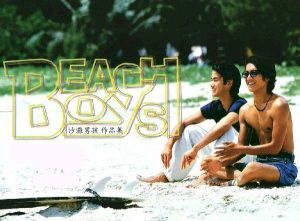This piece first appeared on a blog called Horrorwood Presents, but that site seems to be down now, so I’ve made a few small changes and uploaded it again myself.
Warning: contains spoilers for The Thing (1982)
At first glance, John Carpenter’s seminal sci-fi horror The Thing (1982) may seem an unlikely place to meet representations of Jungian psychological analysis. Really though, I can think of no better way to explore ideas of the self and individuation than through the story of a shape-shifting alien that assimilates other organisms and imitates them perfectly.
The Thing tells the story of an all-male group of scientists, researchers, and support crew stationed at an isolated Antarctic research outpost facing the intrusion of a shape-shifting alien seeking to assimilate and destroy them. Given the perfect imitations made by the titular alien Thing, an atmosphere of paranoia and panic quickly poisons the outpost. The Thing is only identifiable during its messy transformations, making it all the more difficult to detect. We follow the characters as they try to identify and then destroy the alien interloper among them, with the Thing slowly and stealthily working its way through the outpost’s crew.
By considering both internal and external journeys and transformations of the film’s human characters and the Thing, we will see how the film explores identity and individuality through the Jungian ideas of mythology, individuation, liminality, and archetype.
There are various angles these ideas can be explored from, like examining the alien pathology of the alien Thing itself, and its methods of assimilation. Or looking at the archetypal imagery that is manifested throughout, or considering the isolated setting the action takes place in. Don’t worry, I’ll give definitions for all this stuff as we go along, which will hopefully make it all a bit more clear. First, we’ll start with Mythology and Archetype.
Mythology and Archetype

Mythology is the collected stories (or myths) shared throughout a specific group of people. For example, in religion, the words of Jesus Christ make up part of various Christian mythologies. In popular American culture, there is the mythology of the wild west, an untamed frontier just waiting to be conquered and subdued by American settlers(we’ll come back to that!).
Jung describes archetypal imagery as “images and themes which have universal meanings across cultures which may show up in dreams, literature, art or religion.”1 Jung focused on the archetypes of the self, the Persona, the Mother, and the Anima/Animus, but there are also various other archetypes such as the Trickster, Wise Old Man, or the Hero. You’ve probably come across many characters in film who fit neatly into many of these archetypes. Think of Gandalf, the Wise Old Man of The Lord of the Rings, or Luke Skywalker, Hero of Star Wars. But how do these things relate to The Thing?
The film opens in outer-space, a shot of black space and endless stars just outside Earth’s atmosphere, as a flying saucer emerges from the blackness and hurtles towards Earth. According to John Izod in Jung and Film, Jung argued that in the 1950s, Unidentified Flying Objects were “a collective manifestation of the fears aroused in the Western nations by the Cold War” and “most certainly carriers of archetypal energies.”2 The Thing would not be out of place in the 1950s as an allegory for McCarthyism, the idea that nefariously intentioned communists were walking among us, hiding in plain sight, a malicious and corrupting force which needs to be urgently detected and destroyed. We can easily see how that might apply to the shapeshifting and deceptive alien of The Thing! Through connections and connotations like this, we can see Western mythology being mined right from The Thing‘s very beginnings.

Immediately following the opening, the film cuts to a helicopter traversing its primary setting: inhospitable and isolated Antarctic frozen snowfields housing the research outpost in which our main characters reside. The outpost itself speaks to man’s resourcefulness and ingenuity, given the technological knowledge and engineering prowess required to build and maintain the outpost in such a harsh and isolated environment, epitomizing that mythological frontier spirit. However, this very isolation, emphasized by shots of vast and empty snowfields as we follow the helicopter, underlines the fragility of this safe haven and the improbability of any outside assistance should things go awry. In Dark Directions: Romero, Craven, Carpenter, and the modern horror film, Kendall R. Phillips likens the Thing and its setting to the American mythology of the frontier, of that pioneering Western society pushing into the wild: taming, taking over, and civilising. In The Thing the frontier acts as “a liminal space in between the normal structures of society and the dangerous realms of the wild and uncivilised”3 and the frontier myth is turned on its head with the creature itself acting as pioneer, “although a pioneer encroaching into the territory the humans had long assumed was theirs- and now they are the ones being pushed out.”4
Liminality
Liminality is “a state of transition between one stage and the next, especially between major stages in one’s life or during a rite of passage.” (Courtesy of Dictionary.com). Essentially it is a state of “in-between”, and just as the setting works as a “liminal space” for Phillips, the creature itself displays a great deal of liminality, given that it undertakes a number of transformations throughout the film.
The first transformation is of the Thing posing as a dog in the kennels, which erupts into a monstrous, tentacled entity consuming and assimilating the other canine occupants of the kennel. The choice of dog as interloper plays with the mythological ideal of dogs in Western culture on two levels, in which dogs, from Greyfriar’s Bobby to Lassie to Fry’s dog Seymour in Futurama, are continually portrayed as loyal and trusted companions. Firstly, the dog Thing was able to easily enter into the domain of the outpost due to this cultural love and trust of dogs, and secondly in destroying and consuming all of the real dogs, the Thing deprives the humans of trusted and loyal allies. In this sense the Thing uses mythology to its advantage, and then shatters it.
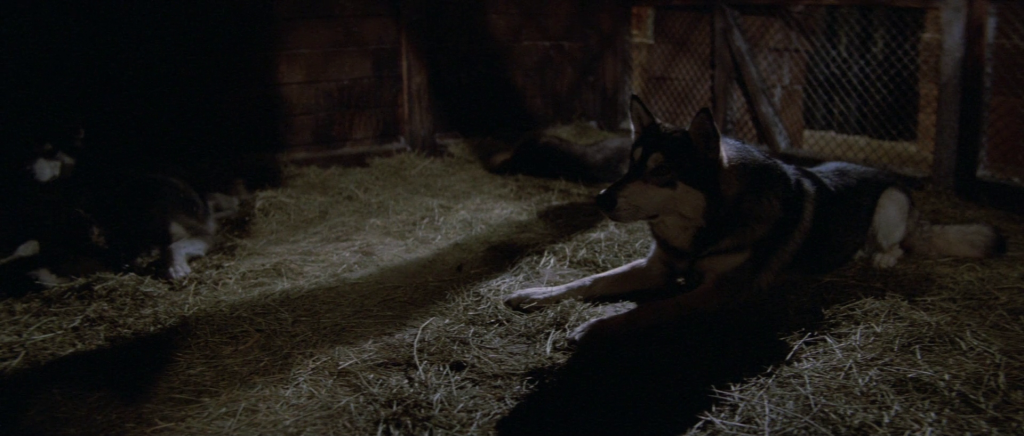
Beginning with the scene in the kennels, the transformations depicted on-screen are all highly kinetic, grotesque and dripping with entrails and viscera, which make the Thing’s identity and alien-ness incredibly evident to the human occupants of the outpost. These violent and exceptionally visual transformations display intense liminality, as, “In liminal experience, the so-called inner and so-called outer worlds come together, collide, collapse, merge, flow into one another, and in the process change each other forever,,”5 so this generally internal psychological process is manifested through the collapsing, colliding, merging transformations of the Thing. Bob Trubshaw associates the liminal phase with “protracted periods of seclusion”6 (Trubshaw 1995), and this is certainly case for the Thing, as the success of its transformations is entirely dependent on its seclusion and remaining unseen. If we consider the Thing’s goal in transformation to be mimicking and passing as human, this can only be achieved if the transformation is unobserved by others, or else the Thing fails in passing through the threshold to believably human, and reverts back to being markedly alien. Given the frequency with which the Thing is forced to transform, it can only be said to achieve “’temporary liminality’ – the ritual or metaphorical activity which allows a person to transform from one social state to another”7, going from the state of ‘alien’ to ‘human’ until inevitably rooted out by a genuine human and forced to again attempt its transformations and assimilations to survive and blend in once more.
Individuation

Given the paranoia of the human characters in the film surrounding who among them may be the alien Thing, it’s interesting to consider the process of individuation.
In Myth, Mind, and the Screen, John Izod describes individuation as “the process of discovery by which the individual approaches knowledge of the self.”8 Essentially, this is the process through which a person becomes an individual, differentiated from the collective.
In a world where the only thing that seems truly knowable is your own humanity, knowledge of the self becomes ever more critical. Even this knowledge comes under doubt, as the alien’s mechanisms and the completeness of its mimicry are not made clear in the film. It’s possible that the mimicry could be so perfect that the mimicked organism doesn’t even realize they are a copy. Descartes certainly did not account for shape-shifting alien mimics when it came to “I think. Therefore I am.”
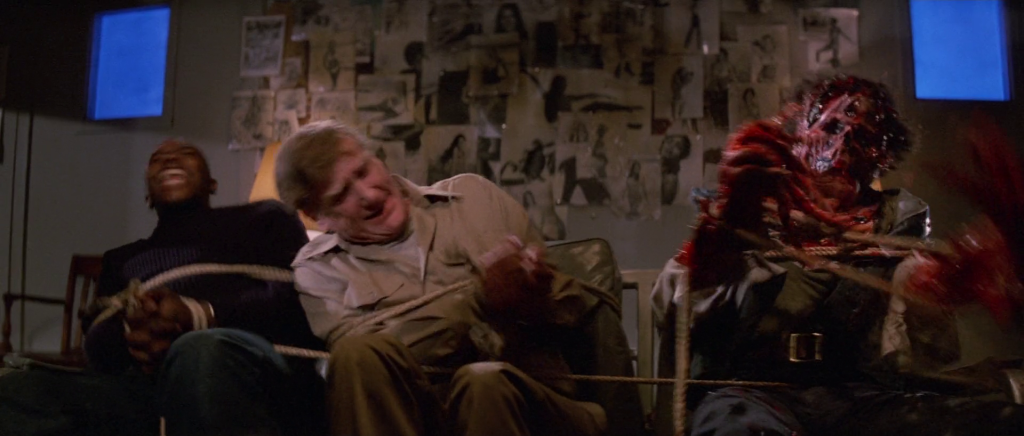
The distrust and discord sewn by the Thing’s presence in the outpost create further difficulty in the individuation process, as the self’s definition is tied to positive interactions with others. As Robert Cumbow puts it in Order in the Universe: The Films of John Carpenter: “With the loss of trust in one’s fellow man comes the loss of one’s own sense of identity.”9 Furthermore, the Thing also attacks the collective as it “individuates, picking off its lone victims one by one, and thereby, with startling efficiency, undermines the communitarian values through which […] the Antarctic research outpost nominally constitutes itself.”10 The Thing consumes, destroys, assimilates, “a metaphor for the already deteriorated condition of human interaction: deception, dishonesty and distrust,”11 but how can we come to understand it? What archetypal imagery does it invoke?
Archetypal Imagery and The Monstrous Feminine
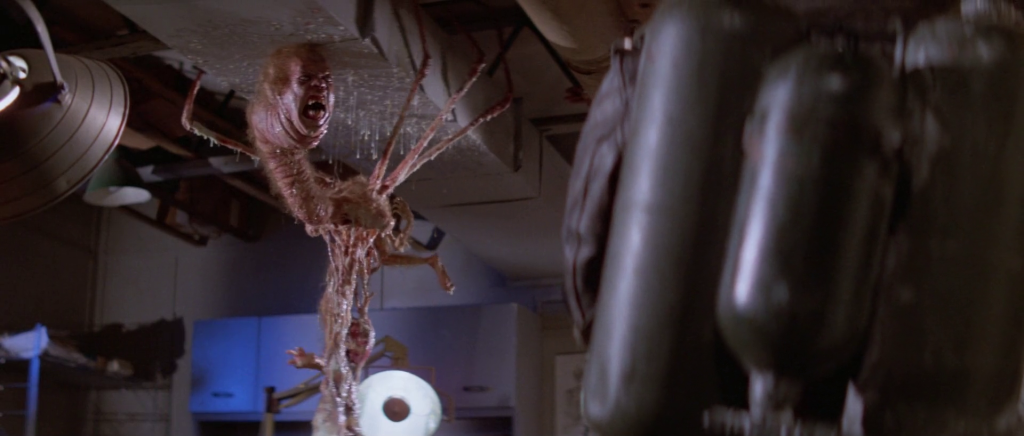
Facets of various archetypes manifest themselves in the Thing, the most immediately obvious of which is that of the shadow, the representation of the dark sides of human nature, “the dark, unknown part of the personality that lies in the unconscious.”12 More specifically we can see the Thing as trickster, “A specialised variant of the shadow typified by changeability,”13 and changeability is amply demonstrated through the Thing’s numerous transformations. The deceptive and destructive power of the Thing and its trickster nature of changeability “make us aware of the dangers of extremes: cultural stalemate on the one hand, and constant change on the other,”14 and presents a formidable threat to the human characters of The Thing and humanity itself.
It’s also interesting to consider the Thing as anima, representing the male personality’s hidden feminine aspects, juxtaposing this with the outpost’s all-male makeup. In her BFI Film Classics book on The Thing, Anne Billson positions the Thing as a female intruder in an all-male space: “The entire film becomes the story of man’s desperate attempts to preserve the beleaguered masculine identity that is constantly under siege from predatory woman, the female gender being a breed apart, considered as somehow not quite human.”15
Billson points to evocations of vagina dentata in the defibrillator scene in which a man’s chest caves in to reveal snapping teeth which take off a man’s arms before the Thing begins another of its transformations, and as further evidence highlights the portrayal of the Thing as a spider-like creature in some transformations. As Billson tells us, spiders are historically “nearly always presented as predatory and malevolent, and often as female.” Furthermore, the anima is often seen as “a confusing, deceptive presence with the capacity to engender inner transformation,”16 and the Thing is undoubtedly deceptive and confusing. However, its transformations are shockingly and vividly external.
The Hero’s Journey
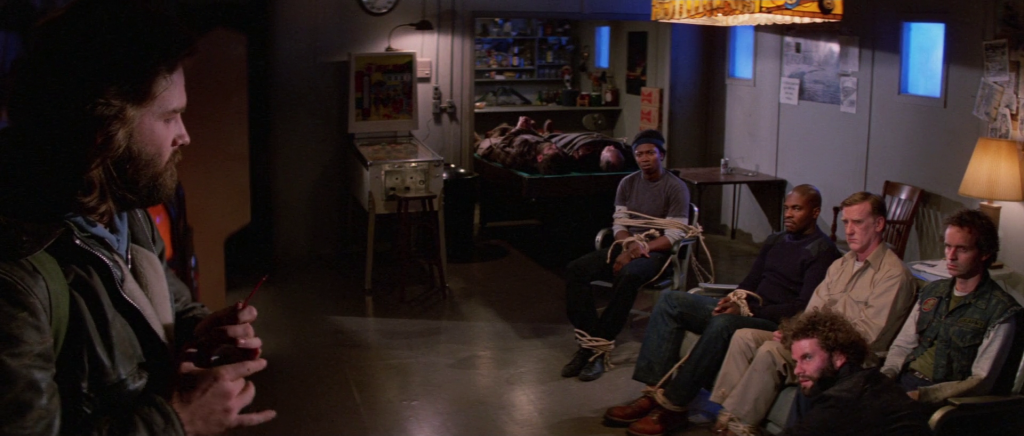
It’s also possible to look at The Thing through the lens of the Hero’s Journey’s, detailed in Joseph Campbell’s The Hero with a Thousand Faces. The hero of a story undertakes a journey of individuation. According to Campbell, in the process of completing their journey the hero of a story should face various dangers throughout, and thus complete their journey a psychologically changed person. They will encounter archetypal imagery manifested through characters of the story, which Campbell tells us must be incorporated for them to become the self.17 That incorporation is “individuation”.
The most likely hero candidate in The Thing is the protagonist, the pilot MacReady (Kurt Russell), who we follow as he encounters and battles the Thing throughout the film. He is the de facto leader of the group, but despite his obvious gravitas and capability, his position is seemingly only because he’s the first one to commandeer the flamethrower, rather than through popularity or democracy.
Given the relative lack of in-depth characterization for many of the supporting characters, it’s difficult to position MacReady’s journey of individuation through his interactions with them. Instead, it is undertaken through his exchanges with the Thing, which, as discussed, acts chiefly as a tricksterish shadow. MacReady battles with the Thing throughtout, and “to struggle with the Shadow and to confront the abject, is one of the tasks of individuation.”18
By the end of the film and MacReady’s journey, we find him sitting among the destroyed and flaming ruins of the outpost with mechanic Childs (Keith David), sharing a bottle of whisky and waiting for death. MacReady is certainly changed from his position at the beginning of the film, but the nature of the change is entirely unclear. Is he victorious, satisfied in vanquishing the Thing and saving humanity (at least for now)? Or, has he been assimilated and become alien himself? The film leaves this ambiguous, allowing the tension and confusion of the story to seep through the screen into the minds of the audience.

It is also intriguing to consider the Hero’s Journey from the perspective of the Thing itself as hero. The Thing is paradoxically both individual and collective, “every part down to the cellular level can survive on its own but all in service to a larger network of the mimicked bodies of other species, thus threatening to destroy human individuality as we know it.”19 Parallels can be drawn between the process of individuation where archetypal images are encountered and incorporated in pursuit of the Self with the Thing’s consuming and assimilating nature, and of course its transformations are vivid visualisations of its liminality.
Conclusion and References
Transformation runs clearly throughout The Thing. It’s mythological and metaphorical through the pioneering alien’s encroachment into the human frontier. It can also be seen as individually psychological through the Hero’s Journey. Finally, it’s archetypically through the Thing’s trickster changeability. The violent and visceral transformations depicted throughout continually reinforce these aspects of archetype and mythology. The Thing leaves us trying to determine who among the characters is human while, quite paradoxically, being sure we are seeing something alien.
What we are left with is an unmistakably human story about paranoia and identity.
- Jung, 1947. On the Nature of the Psyche. ↩︎
- Izod 2001, pg. 129. Jung and Film. ↩︎
- Phillips, K. R., 2012, pg. 123-124. Dark Directions: Romero, Craven, Carpenter, and the Modern Horror Film. ↩︎
- Phillips, K. R., 2012, pg. 134. Dark Directions: Romero, Craven, Carpenter, and the Modern Horror Film ↩︎
- Zemmelman, S., 2013, pg. 17. Jung Journal 7(3). ↩︎
- Trubshaw, B., 1995. Mercian Mysteries, 22. ↩︎
- Trubshaw, B., 1995. Mercian Mysteries, 22 ↩︎
- Izod 2001, pg. 217. Myth, Mind, and the Screen. ↩︎
- Cumbow, R., 2002, pg. 117. Order in the Universe: The Films of John Carpenter. ↩︎
- Smith, S., 2004, pg. 37 The Cinema of John Carpenter: The Technique of Terror. ↩︎
- Cumbow, R., 2002, pg. 112. Order in the Universe: The Films of John Carpenter. ↩︎
- Connolly, A., 2008, pg. 129. Psyche and the Arts: Jungian Approaches to Music, Architecture, Literature, Painting and Film. ↩︎
- Izod 2001, pg. 220. Myth, Mind, and the Screen. ↩︎
- Bassil-Morozow, H., 2017 pg. 85. International Journal of Jungian Studies, 9(2). ↩︎
- Billson, A., 1997. BFI Modern Classics: The Thing. ↩︎
- Beebe, J., 1992. The Anima in Film. ↩︎
- Campbell, J., 2008, pg. 30. The Hero With A Thousand Faces (Vol. 17). ↩︎
- Hauke, C., 2002, pg. 109. Jung and Film II: The Return. ↩︎
- Addison, H., 2013, pg. 162. Journal of Popular Film and Television, 41(3). ↩︎


